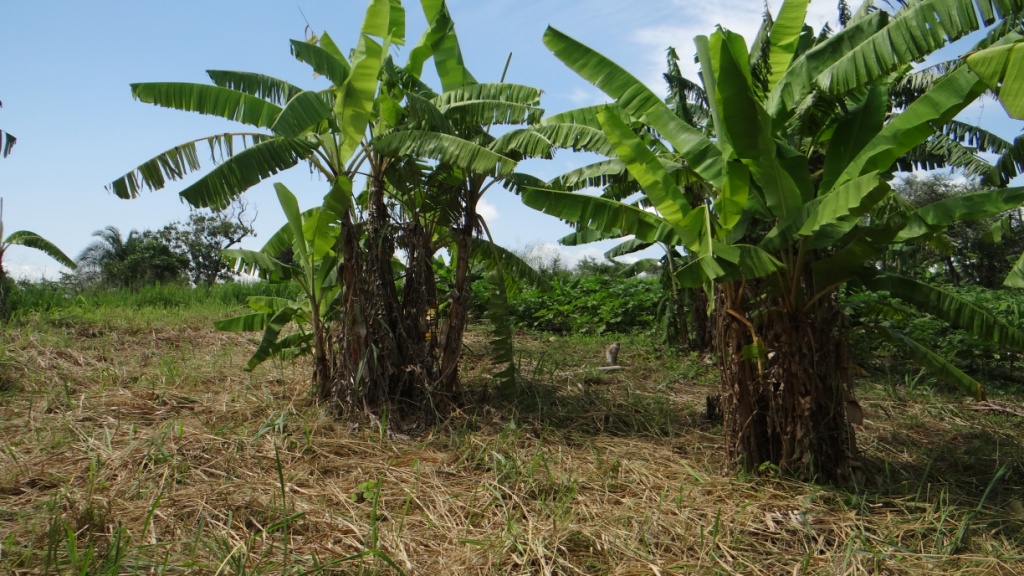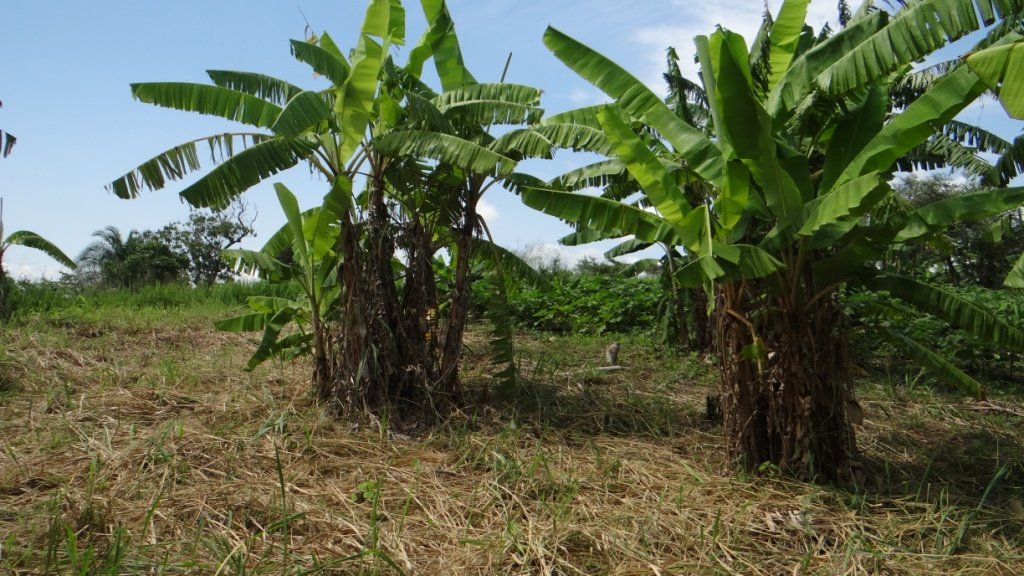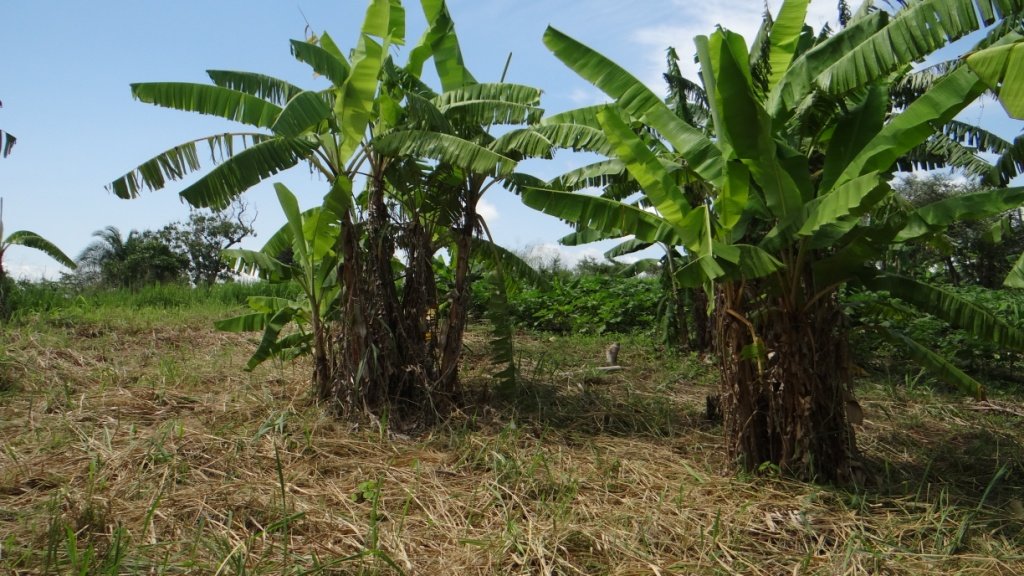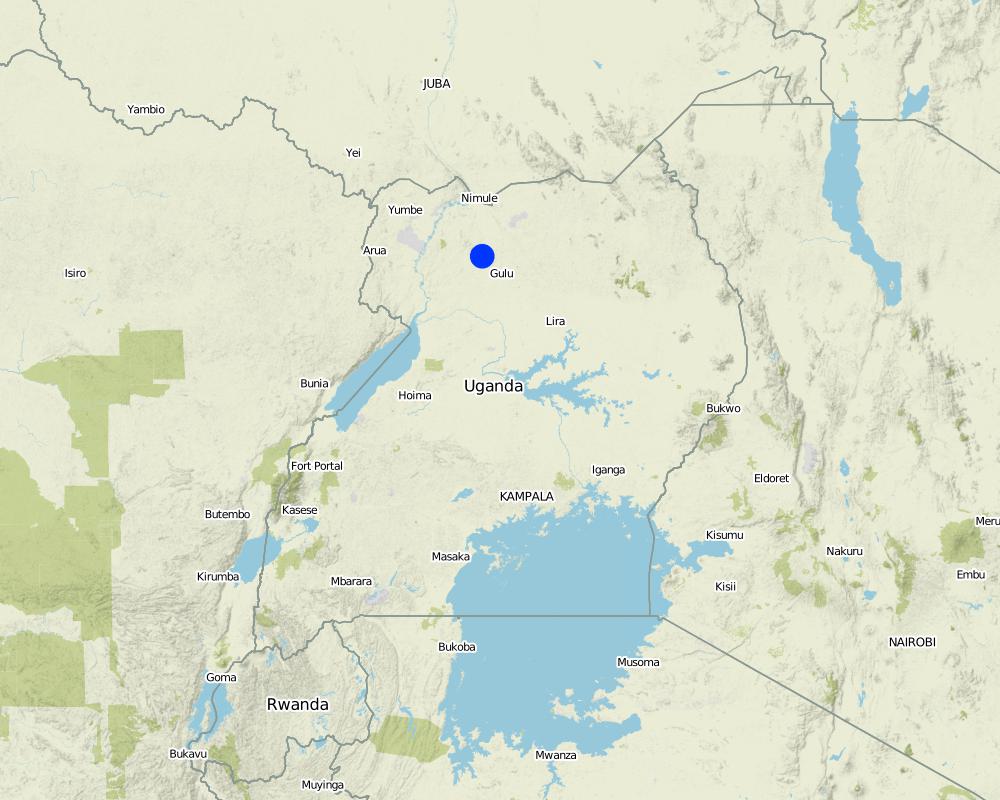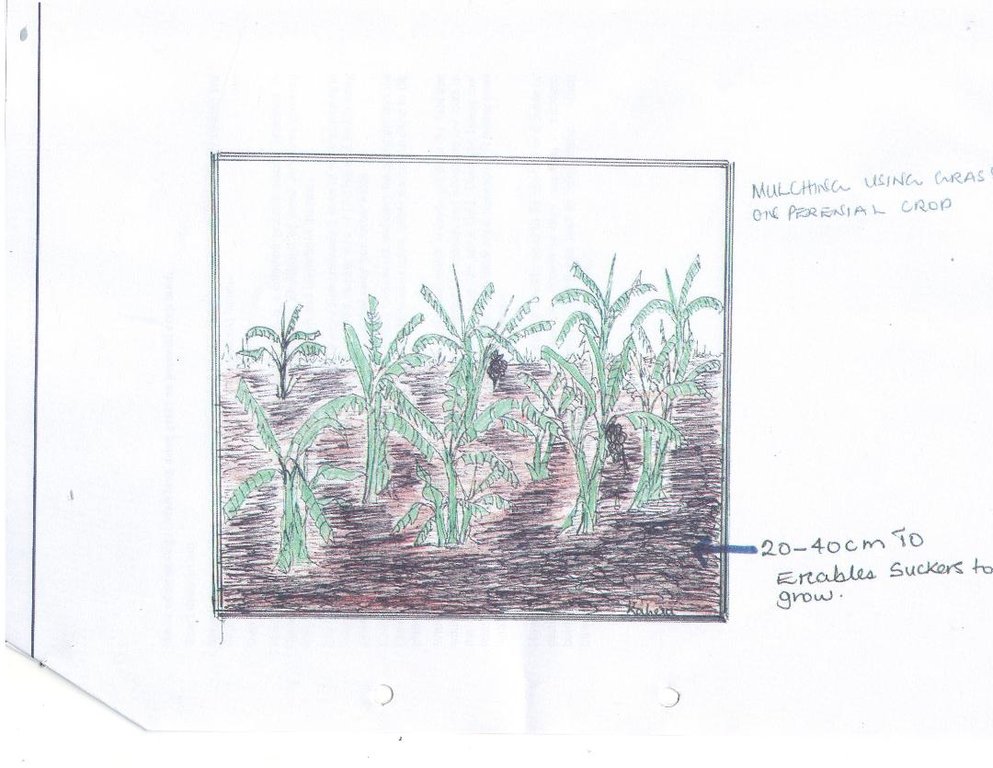Mulching using grass on perennial crop land. [Uganda]
- Creation:
- Update:
- Compiler: Kamugisha Rick Nelson
- Editors: JOY TUKAHIRWA, Richard Otto Kawawa, Bernard Fungo
- Reviewers: Donia Mühlematter, John Stephen Tenywa, Drake Mubiru, Nicole Harari, Renate Fleiner, Stephanie Jaquet, Alexandra Gavilano
Pot Labolo me umu poto
technologies_2818 - Uganda
View sections
Expand all Collapse all1. General information
1.2 Contact details of resource persons and institutions involved in the assessment and documentation of the Technology
Key resource person(s)
land user:
Nyeko Richard
Gen Gari Farm
Uganda
Name of project which facilitated the documentation/ evaluation of the Technology (if relevant)
Scaling-up SLM practices by smallholder farmers (IFAD)Name of the institution(s) which facilitated the documentation/ evaluation of the Technology (if relevant)
CDE Centre for Development and Environment (CDE Centre for Development and Environment) - Switzerland1.3 Conditions regarding the use of data documented through WOCAT
The compiler and key resource person(s) accept the conditions regarding the use of data documented through WOCAT:
Yes
1.4 Declaration on sustainability of the described Technology
Is the Technology described here problematic with regard to land degradation, so that it cannot be declared a sustainable land management technology?
No
2. Description of the SLM Technology
2.1 Short description of the Technology
Definition of the Technology:
Laying grass (Poaceae) on perennial cropped land to reduce weeds, retain soil moisture and improve soil fertility.
2.2 Detailed description of the Technology
Description:
Mulching using grass (Poaceae) on banana cropped land is a common practice usually promoted by farmers in Northern Uganda with the aim of increasing soil fertility, reducing the likelihood of weed problems growing around perennial plants, increase production and household income.
The farmer identifies a field planted with banana approximately 2 acres of land measuring at least 80 metres wide and 240 metres long located on a gentle sloping area of (3-5%), and mulch using grass which is grown in the planted banana garden. The mulch grass used comes from the same field carried away from other fields.
Using a panga the farmer uses 5 people paid on daily basis to cut and carry the grass and lay the grass at a distance of not more than 20- 40 cm to enable the suckers grow and to allow manure too close to the plant after grass decomposition and helps weeds control,
With this technology, the farmer uses locally obtained grass mulch which is easily comes from the banana field that would considered a waste. Secondly the associated costs are only related to transport and labour are low both in the short and long term since the mulch used is obtained from the same field. Costs for labour and transport are incurred only when the mulch material is carried from other areas. Some others costs are for weeding which would be borne by the farmer.
However, the farmer need to know that organic mulches usually need to be applied in a loose or partially-rotted state or the first stages of decomposition, otherwise they can lead to nitrogen being taken from the soil, or anaerobic decomposition which can lead to ‘sour mulch’ which turns acidic and damages the plants it is supposed to be protecting. This advice can best be extended to the farmer by extension workers and expert farmers who the farmer needs to be if close contact during implementation of this technology.
2.3 Photos of the Technology
2.4 Videos of the Technology
Comments, short description:
Video showing Mulching using grass on perennial crop land under banana in Amuru District.
Date:
15/12/2017
Location:
Amuru District, Northern Uganda
Name of videographer:
Issa Aiga
2.5 Country/ region/ locations where the Technology has been applied and which are covered by this assessment
Country:
Uganda
Region/ State/ Province:
Northern Region,Uganda
Further specification of location:
Amuru District, Northern Uganda
Specify the spread of the Technology:
- evenly spread over an area
If precise area is not known, indicate approximate area covered:
- < 0.1 km2 (10 ha)
Comments:
Map showing technology site in Northern Uganda.
Map
×2.6 Date of implementation
Indicate year of implementation:
2010
If precise year is not known, indicate approximate date:
- less than 10 years ago (recently)
2.7 Introduction of the Technology
Specify how the Technology was introduced:
- through land users' innovation
- through projects/ external interventions
Comments (type of project, etc.):
The farmer was supported with training by National Agricultural Advisory Services (NAADS).
3. Classification of the SLM Technology
3.1 Main purpose(s) of the Technology
- improve production
- reduce, prevent, restore land degradation
- adapt to climate change/ extremes and its impacts
- create beneficial economic impact
3.2 Current land use type(s) where the Technology is applied

Cropland
- Annual cropping
- Perennial (non-woody) cropping
Perennial (non-woody) cropping - Specify crops:
- banana/plantain/abaca
Number of growing seasons per year:
- 2
Specify:
Around June - August and February.
Comments:
The farmer has a plantation of 0.5 acres planted next to the banana plantation.
3.4 Water supply
Water supply for the land on which the Technology is applied:
- rainfed
Comments:
integrated soil fertility management
water harvesting
3.5 SLM group to which the Technology belongs
- integrated soil fertility management
- water harvesting
3.6 SLM measures comprising the Technology

agronomic measures
- A1: Vegetation/ soil cover
- A2: Organic matter/ soil fertility

vegetative measures
- V2: Grasses and perennial herbaceous plants
- V3: Clearing of vegetation

structural measures
- S7: Water harvesting/ supply/ irrigation equipment

management measures
- M3: Layout according to natural and human environment
- M5: Control/ change of species composition
3.7 Main types of land degradation addressed by the Technology

soil erosion by water
- Wt: loss of topsoil/ surface erosion
- Wg: gully erosion/ gullying

chemical soil deterioration
- Cn: fertility decline and reduced organic matter content (not caused by erosion)

biological degradation
- Bc: reduction of vegetation cover
- Bs: quality and species composition/ diversity decline
- Bl: loss of soil life
3.8 Prevention, reduction, or restoration of land degradation
Specify the goal of the Technology with regard to land degradation:
- prevent land degradation
- restore/ rehabilitate severely degraded land
Comments:
Due to the decomposition of the mulched grass material.
4. Technical specifications, implementation activities, inputs, and costs
4.1 Technical drawing of the Technology
4.2 General information regarding the calculation of inputs and costs
Specify how costs and inputs were calculated:
- per Technology area
Indicate size and area unit:
2 acres
other/ national currency (specify):
UGX
If relevant, indicate exchange rate from USD to local currency (e.g. 1 USD = 79.9 Brazilian Real): 1 USD =:
3400.0
Indicate average wage cost of hired labour per day:
5000
4.3 Establishment activities
| Activity | Timing (season) | |
|---|---|---|
| 1. | Select the site planted with banana | Before establishment |
| 2. | Look for pangas to cut the grass | Once before establishment |
| 3. | look for labour to cut and carry the grass | Before establishment |
| 4. | Cut and curry grass using labour | During establishment |
| 5. | Lay the grass in the soil | During establishment |
Comments:
More workload for cutting, carrying and drying grass.
4.4 Costs and inputs needed for establishment
| Specify input | Unit | Quantity | Costs per Unit | Total costs per input | % of costs borne by land users | |
|---|---|---|---|---|---|---|
| Labour | persons days for cutting, carrying and laying grass | persons | 5.0 | 150000.0 | 750000.0 | 100.0 |
| Equipment | Hoe | pieces | 5.0 | 10000.0 | 50000.0 | 100.0 |
| Equipment | Panga | Pieces | 5.0 | 7000.0 | 35000.0 | 100.0 |
| Plant material | Suckers in case the farmer want to add mulching | Suckers | 200.0 | 5000.0 | 1000000.0 | 100.0 |
| Other | Transport | Lorry | 1.0 | 100000.0 | 100000.0 | |
| Total costs for establishment of the Technology | 1935000.0 | |||||
| Total costs for establishment of the Technology in USD | 569.12 | |||||
Comments:
Transport costs are incurred if the farmer obtains the grass from other area .
4.5 Maintenance/ recurrent activities
| Activity | Timing/ frequency | |
|---|---|---|
| 1. | Add mulch to the banana field after decomposition | Twice a year |
Comments:
The farmer may not need to incur additional costs if does not want to add mulch in the garden. This reduces labour costs.
4.6 Costs and inputs needed for maintenance/ recurrent activities (per year)
| Specify input | Unit | Quantity | Costs per Unit | Total costs per input | % of costs borne by land users | |
|---|---|---|---|---|---|---|
| Labour | Persons days for adding mulch | Persons | 3.0 | 150000.0 | 450000.0 | 100.0 |
| Total costs for maintenance of the Technology | 450000.0 | |||||
| Total costs for maintenance of the Technology in USD | 132.35 | |||||
4.7 Most important factors affecting the costs
Describe the most determinate factors affecting the costs:
Labour for cutting , carrying and laying grass and seedlings take the most costs. However this means that if the farmer does not need to add more suckers.
5. Natural and human environment
5.1 Climate
Annual rainfall
- < 250 mm
- 251-500 mm
- 501-750 mm
- 751-1,000 mm
- 1,001-1,500 mm
- 1,501-2,000 mm
- 2,001-3,000 mm
- 3,001-4,000 mm
- > 4,000 mm
Specify average annual rainfall (if known), in mm:
1400.00
Specifications/ comments on rainfall:
Two rainy season and two dry season.
Rainy season: March to May and September to November
Dry season: December to February and June - August
Agro-climatic zone
- humid
5.2 Topography
Slopes on average:
- flat (0-2%)
- gentle (3-5%)
- moderate (6-10%)
- rolling (11-15%)
- hilly (16-30%)
- steep (31-60%)
- very steep (>60%)
Landforms:
- plateau/plains
- ridges
- mountain slopes
- hill slopes
- footslopes
- valley floors
Altitudinal zone:
- 0-100 m a.s.l.
- 101-500 m a.s.l.
- 501-1,000 m a.s.l.
- 1,001-1,500 m a.s.l.
- 1,501-2,000 m a.s.l.
- 2,001-2,500 m a.s.l.
- 2,501-3,000 m a.s.l.
- 3,001-4,000 m a.s.l.
- > 4,000 m a.s.l.
Indicate if the Technology is specifically applied in:
- concave situations
5.3 Soils
Soil depth on average:
- very shallow (0-20 cm)
- shallow (21-50 cm)
- moderately deep (51-80 cm)
- deep (81-120 cm)
- very deep (> 120 cm)
Soil texture (topsoil):
- medium (loamy, silty)
Soil texture (> 20 cm below surface):
- medium (loamy, silty)
Topsoil organic matter:
- medium (1-3%)
5.4 Water availability and quality
Ground water table:
< 5 m
Availability of surface water:
medium
Water quality (untreated):
poor drinking water (treatment required)
Is water salinity a problem?
No
Is flooding of the area occurring?
No
5.5 Biodiversity
Species diversity:
- low
Habitat diversity:
- low
5.6 Characteristics of land users applying the Technology
Sedentary or nomadic:
- Sedentary
Market orientation of production system:
- subsistence (self-supply)
Off-farm income:
- less than 10% of all income
Relative level of wealth:
- poor
Individuals or groups:
- individual/ household
Level of mechanization:
- manual work
Gender:
- men
Age of land users:
- middle-aged
Indicate other relevant characteristics of the land users:
The farmer is a carpenter from which he derives his additional income.
5.7 Average area of land used by land users applying the Technology
- < 0.5 ha
- 0.5-1 ha
- 1-2 ha
- 2-5 ha
- 5-15 ha
- 15-50 ha
- 50-100 ha
- 100-500 ha
- 500-1,000 ha
- 1,000-10,000 ha
- > 10,000 ha
Is this considered small-, medium- or large-scale (referring to local context)?
- small-scale
5.8 Land ownership, land use rights, and water use rights
Land ownership:
- individual, not titled
Land use rights:
- individual
Water use rights:
- open access (unorganized)
Comments:
Presence of a community bore hole
5.9 Access to services and infrastructure
health:
- poor
- moderate
- good
education:
- poor
- moderate
- good
technical assistance:
- poor
- moderate
- good
employment (e.g. off-farm):
- poor
- moderate
- good
markets:
- poor
- moderate
- good
energy:
- poor
- moderate
- good
roads and transport:
- poor
- moderate
- good
drinking water and sanitation:
- poor
- moderate
- good
financial services:
- poor
- moderate
- good
6. Impacts and concluding statements
6.1 On-site impacts the Technology has shown
Socio-economic impacts
Production
crop production
Quantity before SLM:
25 bunches per month.
Quantity after SLM:
35 bucnhes per month.
crop quality
Comments/ specify:
Water moisture retention, better growth.
land management
Comments/ specify:
Mulch grass locally available, less costs, use of local labour.
Income and costs
expenses on agricultural inputs
Comments/ specify:
Purchase of hoes and pangas which don't take a lot of money.
farm income
Comments/ specify:
From the sale of banana.
workload
Comments/ specify:
Reduced work load in the long run.
Socio-cultural impacts
SLM/ land degradation knowledge
Comments/ specify:
Knowledge on how to mulch and distance.
Ecological impacts
Water cycle/ runoff
water quantity
Comments/ specify:
Retained by the mulched material.
harvesting/ collection of water
Comments/ specify:
Due to use of mulch material.
surface runoff
Comments/ specify:
Because of mulching.
Soil
soil moisture
Comments/ specify:
Kept within the mulch.
soil cover
Comments/ specify:
Mulch material.
soil loss
Comments/ specify:
Reduced due to application of mulching
soil organic matter/ below ground C
Comments/ specify:
Due to decomposition of mulch grass.
6.2 Off-site impacts the Technology has shown
water availability
Comments/ specify:
Kept within the mulch to be utilised by the banana during the dry season.
6.3 Exposure and sensitivity of the Technology to gradual climate change and climate-related extremes/ disasters (as perceived by land users)
Gradual climate change
Gradual climate change
| Season | increase or decrease | How does the Technology cope with it? | |
|---|---|---|---|
| annual temperature | decrease | very well | |
| seasonal temperature | wet/ rainy season | increase | well |
| annual rainfall | decrease | moderately |
Climate-related extremes (disasters)
Biological disasters
| How does the Technology cope with it? | |
|---|---|
| insect/ worm infestation | moderately |
6.4 Cost-benefit analysis
How do the benefits compare with the establishment costs (from land users’ perspective)?
Short-term returns:
positive
Long-term returns:
very positive
How do the benefits compare with the maintenance/ recurrent costs (from land users' perspective)?
Short-term returns:
positive
Long-term returns:
positive
Comments:
Mulching using grass reduced workload in the short run associated with less costs in the long run .The labour that would be used for weeding and its associated costs reduce since no weeding is required when the banana is mulched. Mulching reduces weeds and increases water moist which increases banana production due to decomposed mulched material (grass).
6.5 Adoption of the Technology
- 1-10%
If available, quantify (no. of households and/ or area covered):
5
Of all those who have adopted the Technology, how many did so spontaneously, i.e. without receiving any material incentives/ payments?
- 0-10%
6.6 Adaptation
Has the Technology been modified recently to adapt to changing conditions?
Yes
If yes, indicate to which changing conditions it was adapted:
- climatic change/ extremes
Specify adaptation of the Technology (design, material/ species, etc.):
Planting fertilizer trees (Calliandra).
6.7 Strengths/ advantages/ opportunities of the Technology
| Strengths/ advantages/ opportunities in the land user’s view |
|---|
| Control weeds and improve soil fertility after decomposition. |
| Uses local available grass materials within the banana (musa) garden for mulching which would be considered a waste. |
| Cost effective. Low labour and transport costs since the grass mulch is locally obtained within the same field. |
| Strengths/ advantages/ opportunities in the compiler’s or other key resource person’s view |
|---|
| Appropriate for farmers with low income. |
| Is scalable, requires low labour and input costs. |
6.8 Weaknesses/ disadvantages/ risks of the Technology and ways of overcoming them
| Weaknesses/ disadvantages/ risks in the land user’s view | How can they be overcome? |
|---|---|
| Harbours insects which attack young suckers. | Apply pesticides. |
| The technology is easily affected by roaming animals searching for pasture during the dry season when there is normally shortage of pasture. |
Put in place byelws on controlled grazing Integrate fertilizer trees (calliandra and Grivellea) in the practice as an alternative. |
| Weaknesses/ disadvantages/ risks in the compiler’s or other key resource person’s view | How can they be overcome? |
|---|---|
| Mulching can increase the risk of diseases especially if the grasses are obtained from outside the garden. | First use the grass in the same field. |
| Mulching alone may not be a solution to increase production. The farmer needs also to mange well the banana by cutting banana leaves which can also act as mulching material. | Knowledge and skills be provided by the extension agent. |
7. References and links
7.1 Methods/ sources of information
- field visits, field surveys
01
- interviews with land users
01
When were the data compiled (in the field)?
25/05/2017
Links and modules
Expand all Collapse allLinks
No links
Modules
No modules


